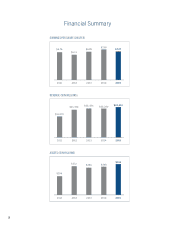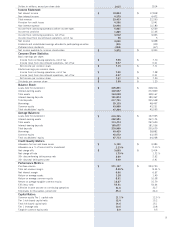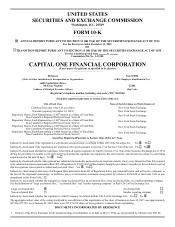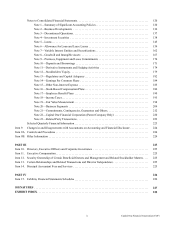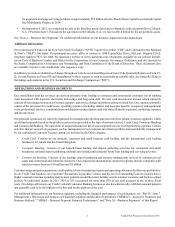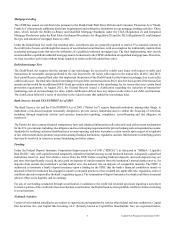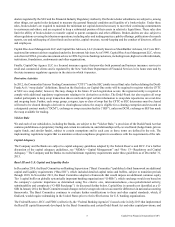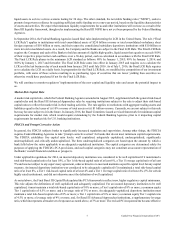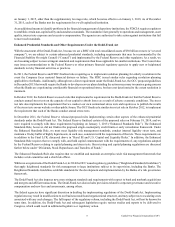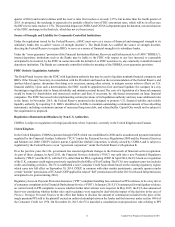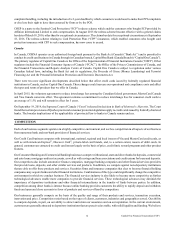Capital One 2015 Annual Report Download - page 22
Download and view the complete annual report
Please find page 22 of the 2015 Capital One annual report below. You can navigate through the pages in the report by either clicking on the pages listed below, or by using the keyword search tool below to find specific information within the annual report.
3 Capital One Financial Corporation (COF)
SUPERVISION AND REGULATION
General
Capital One Financial Corporation is a bank holding company (“BHC”) under Section 3 of the Bank Holding Company Act of
1956, as amended (12 U.S.C. § 1842) (“BHC Act”) and is subject to the requirements of the BHC Act, including its required
approvals for investments in or acquisitions of banking organizations, capital adequacy standards and limitations on our nonbanking
activities. We are also subject to supervision, examination and regulation by the Board of Governors of the Federal Reserve System
(“Federal Reserve”). Permissible activities for a BHC include those activities that are so closely related to banking as to be proper
incidents thereto, such as consumer lending and other activities that have been approved by the Federal Reserve by regulation or
order. Certain servicing activities are also permissible for a BHC if conducted for or on behalf of the BHC or any of its affiliates.
Impermissible activities for BHCs generally include nonfinancial activities such as sales of commercial products.
On May 27, 2005, we became a “financial holding company” under the Gramm-Leach-Bliley Act amendments to the BHC Act
(“GLBA”). The GLBA removed many of the restrictions on the activities of BHCs that become financial holding companies. A
financial holding company, and the nonbank companies under its control, are permitted to engage in activities considered financial
in nature (including, for example, insurance underwriting, agency sales and brokerage, securities underwriting and dealing and
merchant banking activities), incidental to financial activities and, if the Federal Reserve determines that they pose no risk to the
safety or soundness of depository institutions or the financial system in general, activities complementary to financial activities.
For a BHC to become and remain eligible for financial holding company status, the BHC and its subsidiary depository institutions
must meet certain criteria, including capital, management and Community Reinvestment Act (“CRA”) requirements. The failure
to meet such criteria could, depending on which requirements were not met, result in the Company facing restrictions on new
financial activities or acquisitions or being required to discontinue existing activities that are not generally permissible for BHCs.
The Banks are national associations chartered under the laws of the United States, the deposits of which are insured by the Deposit
Insurance Fund (“DIF”) of the Federal Deposit Insurance Corporation (“FDIC”) up to applicable limits. In addition to regulatory
requirements imposed as a result of COBNA’s international operations (discussed below), the Banks are subject to comprehensive
regulation and periodic examination by the Office of the Comptroller of the Currency (“OCC”), the FDIC and the Consumer
Financial Protection Bureau (“CFPB”).
We also are registered as a financial institution holding company under Virginia law and, as such, we are subject to periodic
examination by Virginia’s Bureau of Financial Institutions. We also face regulation in the international jurisdictions in which we
conduct business (see below under “Regulation of International Business by Non-U.S. Authorities”).
Regulation of Business Activities
The business activities of the Company and Banks also are subject to regulation and supervision under various laws and regulations.
Regulations of Consumer Lending Activities
The activities of the Banks as consumer lenders are subject to regulation under various federal laws, including the Truth in Lending
Act (“TILA”), the Equal Credit Opportunity Act, the Fair Credit Reporting Act, the CRA, the Servicemembers Civil Relief Act
(“SCRA”) and the Military Lending Act, as well as under various state laws. Depending on the underlying issue and applicable
law, regulators are often authorized to impose penalties for violations of these statutes and, in certain cases, to order banks to
compensate injured borrowers. Borrowers may also have a private right of action for certain violations. Federal bankruptcy and
state debtor relief and collection laws also affect the ability of a bank to collect outstanding balances owed by borrowers. These
laws may affect the ability of banks to collect outstanding balances.
The Credit Card Accountability Responsibility and Disclosure Act (amending the TILA) enacted in May 2009, and related changes
to Regulation Z, impose a number of restrictions on credit card practices impacting rates and fees, require that a consumer’s ability
to pay be taken into account before issuing credit or increasing credit limits, and update the disclosures required for open-end
credit.



